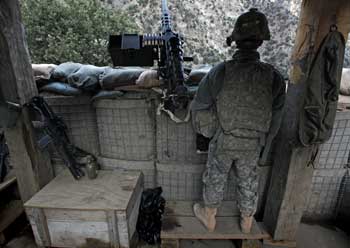CAMBRIDGE - The recent terrorist assault in Mumbai targeted not only India's economy and sense of security. Its broader goal was to smash the India-Pakistan détente that has been taking shape since 2004.
The attackers did not hide their faces or blow themselves up with suicide jackets. Anonymity was not their goal. They wanted to be identified as defenders of a cause. Unless this cause is fully understood, and its roots revealed across the region, this attack may prove to be the beginning of the unmaking of South Asia.
Regional conflict, involving all of the region's states and increasing numbers of non-state actors, has produced large numbers of trained fighters, waiting for the call to glory. Within both India and Pakistan, economic disparities and a sense of social injustice have created fertile ground for conflict. The use or abuse of religious fervor, whether "jihadi" or "Hindu fundamentalist," is striking at the roots of communal harmony across South Asia.
 |
| The Afghanistan crisis is one of the root causes of the problem: A soldier with the US Army's 6-4 Cavalry watches the hills surrounding Combat Outpost Lowell in eastern Afghanistan. Reuters |
Much of the current trouble can be traced to Afghanistan, whose tragedy could never have remained confined within its designated borders. The dynamics of the region changed when the Afghan freedom fighters of 1980s were converted into "mujahidin" through a criminal enterprise in which both the West and the Muslim world happily participated. Pakistan, always insecure about India, became the hub of this transformation. The West thought it had moved on after the fall of the Soviet empire, but the region - and increasingly the global community - continues to pay a heavy price for this unholy project.
The ills of two decades in South Asia can be attributed to the Afghan jihad years: the rise of the Taliban, the dominance of Pakistani-sponsored religious fanatics within the Kashmir freedom movement, and the eventual spread of sectarian conflict within Pakistan. In Afghanistan, Pakistan's military and intelligence agencies sought "strategic depth" against India. Moreover, they wanted payback for India's role in supporting the revolt in the 1960s and 1970s that led to Bangladesh's independence from Pakistan.
India is not blameless here. It was pursuing a two-pronged strategy - making the argument that all was well in Kashmir (a blatant lie) and supporting ethnic confrontation in Pakistan. Violent intelligence wars between Pakistan's Inter-Services Intelligence (ISI) and India's Research and Analysis Wing (RAW) have become a brutal reality in South Asia.
Lashkar-e-Taiba (LET, Army of the Pure), a Pakistan-based militant outfit supporting insurgency on the Indian side of Kashmir, was a product of these years. According to Indian investigators, this group is implicated in the Mumbai attacks. Pakistan's clampdown on its offices throughout the country essentially confirms this conclusion, though Pakistan is publicly demanding more evidence.
LET was the armed wing of an Ahle-Hadith organization, a South Asian version of Saudi-style fundamentalism, whose purpose was to hit Indian forces in Kashmir. Though the group was banned by former Pakistani President Pervez Musharraf after the terrorist attacks on the United States on September 11, 2001, some of its operators went underground and others joined Jamaat-ud-Dawa (JuD, Party of Proselytizing) - an organization that runs religious educational centres and charities.
Given its established linkages with Pakistan's intelligence outfits, the group was never targeted strongly. In fact, it was even involved in rescue operations on the Pakistani side of Kashmir after the devastating 2005 earthquake there.
What Pakistan's military strategists failed to realize was that groups like LET and JuD had local agendas as well - converting Pakistan into a theocracy. Hafiz Saeed, the founder of LET and currently the head of JuD, once proudly argued that: "We believe in the Clash of Civilizations, and our Jihad will continue until Islam becomes the dominant religion."
JuD, along with many other like-minded groups, radicalized thousands of young Pakistanis. Through its web and print publications, it also routinely challenged the teachings of the Sufi mystics who originally brought Islam to South Asia by promoting pluralism and love for humanity.
Even while demanding strong action against JuD, India must recognize that Pakistan is itself a victim of terror. Any military confrontation with Pakistan will only empower Pakistani radicals. India also needs to look inward, as anti-Muslim violence in Gujarat and the activities of Hindu fundamentalist groups have potentially created recruitment opportunities for Muslim extremists within India. An amicable resolution of the Kashmir conflict will only help improve peace prospects in South Asia.
For Pakistan, a concerted and sustained effort against all extremist groups operating in the country is necessary. Militants of all stripes must be decommissioned completely and transparently. Equally important for Pakistan is to expand and reform its public education system and improve basic services so that radical groups cannot lure young people into their educational and welfare networks. Otherwise, the status quo can gravely threaten Pakistan's - and South Asia's - future.
* Hassan Abbas is a fellow at Harvard's Kennedy School of Government and Institute for Policy and Understanding.
Copyright: Project Syndicate, 2009. Exclusive to The Sunday Times
|

